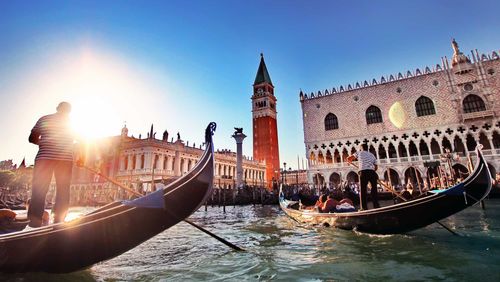Corfu Town
The capital, CORFU TOWN, has been one of the most elegant island capitals in the whole of Greece since it was spruced up for the EU summit in 1994. Although many of its finest buildings were destroyed by Nazi bombers in World War II, two massive forts, the sixteenth-century church of Áyios Spyrídhon and some buildings dating from French and British administrations remain intact. As the island’s major port of entry by ferry or plane, Corfu Town can get packed in summer.
Corfu Town comprises a number of distinct areas. The Historic Centre, the area enclosed by the Old Port and the two forts, consists of several smaller districts: Campiello, the oldest, sits on the hill above the harbour; Kofinéta stretches towards the Spianádha (Esplanade); Áyii Apóstoli runs west of the Mitrópolis (Orthodox cathedral); while tucked in beside the Néo Froúrio is what remains of the old Jewish quarter. These districts and their tall, narrow alleys conceal some of Corfu’s most beautiful architecture. The New Town comprises all the areas that surround the Historic Centre.
The Ionian School of painting
The Ionian islands have a strong tradition of excellence in the fine arts, particularly iconography. Having been occupied by the Venetians and later the British, the islands spent centuries more in touch with developments in western Europe than in the Ottoman empire.
Until the late seventeenth century, religious art in the Ionians, as elsewhere, was dominated by the stylistic purity and dignified austerity of the Cretan School. The founder of the Ionian School of painting is considered to be Panayiotis Dhoxaras, who was born in the Peloponnese in 1662 but, after studying in Venice and Rome, moved to Zákynthos and later lived and worked in Lefkádha and Corfu until his death in 1729. From his travels Dhoxaras absorbed the spirit of Italian Renaissance art, and brought a greater degree of naturalism into iconography by showing his subjects, usually saints, in more human poses amid everyday surroundings. He is also credited with introducing the technique of oil painting into Greece in place of the older method of mixing pigments with egg yolk.
Dhoxaras’s work was carried on by his son, Nikolaos (1710–1775), and over the next two centuries the tradition flourished through the skilled brushwork of a host of talented artists, such as Corfiot Yioryios Khrysoloras (1680–1762), Zakynthian Nikolaos Kandounis (1768–1834) and three generations of the Proselandis family, starting with Pavlos Proselandis (1784–1837).
Mount Pandokrátor
Mount Pandokrátor, Corfu’s highest mountain, is crowned by the moderately interesting Pandokrátoras monastery, whose main sanctuary, built in the seventeenth century, is open to visitors; nothing remains of the original buildings from three centuries earlier.
The most direct route from the south is signposted via Spartýlas and then the village of Strinýlas, a popular base for walkers served by buses from Corfu Town. An alternative approach from the north coast goes via Loútses to the charming ghost village of Áno Períthia, from where you are a steep 5km from the summit and can only climb any higher on foot or in a four-wheel drive. Apart from taking a quick peek at the crumbling remains of half a dozen churches, there is good eating in the village. The main westerly route ascends via Láfki to Petália, just south of which a paved road leads the final 5km east to the summit.
Anyone interested in walking the Pandokrátor paths is advised to get the map of the mountain by island-based cartographer Stephan Jaskulowski or one of Hilary Whitton-Paipeti’s walking books, available from the better English-language bookshops in Corfu Town.
Walking the Corfu Trail
The Corfu Trail, 200km in length and open since 2001, covers the whole island from Cape Asprókavos in the south to Áyios Spyrídhon beach, next to Cape Ayías Ekaterínis in the far north. The route avoids roads as much as possible and takes walkers across a variety of terrain – from beaches to the highest peaks – passing by Lefkími, Korissíon lagoon, Áyii Dhéka, Pélekas, Myrtiótissa, Paleokastrítsa, Áyios Yeóryios Pagón, Spartýlas and Mount Pandokrátor.
Paths along the entire route are waymarked with yellow aluminium signs. As usual, ramblers are advised to wear headgear and stout footwear and carry ample water and provisions, as well as all-weather kit in all but the high summer months. It is reckoned that strong walkers can cover the route in ten days.
Those interested in attempting all or part of the trail should pick up Hilary Whitton Paipeti’s excellent Companion Guide to the Corfu Trail (corfutrailguide.com; €10), which contains detailed maps and descriptions of the route, divided into ten daily sections. A proportion of the profits goes towards maintenance of the trail, and anyone using the trail is asked to contribute €3 for the same reason. You can also log on to travelling.gr/corfutrail for information on organized walking packages, including accommodation.











































